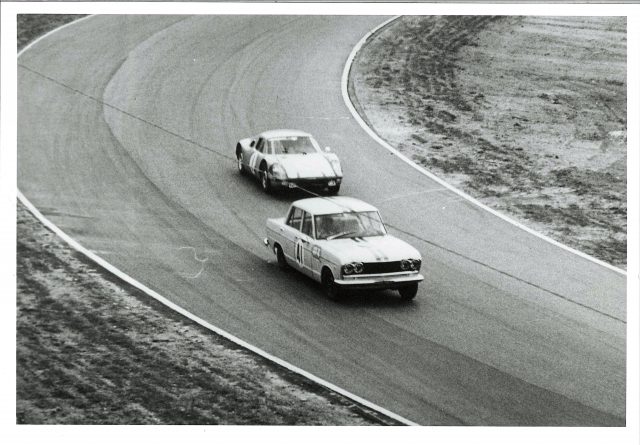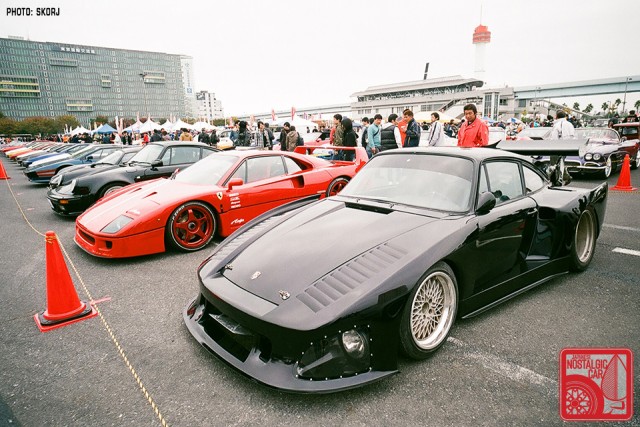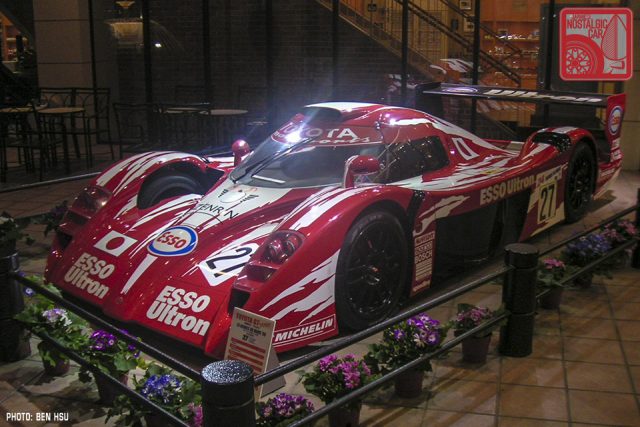One of the world’s great motoring contests, the 24 Hours of Le Mans, takes place this weekend. Toyota was already a strong favorite to win, but now even more so after Kamui Kobayashi pulverized the track record during his qualifying lap. If he wins, it could send massive reverberations through Japan’s car culture.
“Actually, it doesn’t really matter if younger Japanese people are not buying cars, what matters more is if North American younger people are not buying cars. This is more important for the Japanese car industry.” Those are the words of former Nissan racing driver Yoshikazu Sunako, a man who was there in his Prince Skyline GT when the first wave of true car enthusiasts was born in Japan.
That fateful moment in 1964 when what was essentially a family sedan with a hot rod straight-six passed a Porsche 904, a machine built solely for racing, gave resonance to the name “Skyline.” Not only did the name outlive the marque that gave birth to it, Nissan continued to campaign it as its flagship touring car for decades after it absorbed Prince.
However, it was much more than just the fact that a Prince had overtaken a Porsche. It was the fact that a domestic Japanese car had overtaken the best thoroughbred racing machine the world had to offer. See, in the early 1960s, Japanese cars were still pretty far behind the rest of the industry. Thanks to Henry Ford the automobile had for 50 years been an inalienable human right in the West, whereas the entire concept of private car ownership had existed in Japan for less than a decade.




In the blink of an eye, though, Japan’s carmakers would jump feet first into every type of motorsport you can think of. Motorsport practically became a right of passage, capturing the imagination of a generation. That generation, who witnessed Hakosuka GT-Rs duke it out at Fuji Speedway, Lancers conquer the wild terrain of Africa, Mazda rotaries withstand grueling enduros, and Honda take on the world’s best in Formula One, infiltrated Japan’s automotive giants and took that passion with them.
You can trace the exact arc that led from that golden age to the performance-minded engineering of the Bubble Era to the Tuner Era and the flood of NSXes, GT-Rs, Supras, RX-7s, Evos and STIs you lustily dream of today. By the turn of the century, many of the octane-veined founding fathers of Japan’s auto industry had either passed away or retired. From there, you see a direct correlation with the extinction of Japanese performance cars in the 2000s.
Which brings us back to Sunako-san’s statement. He’s right, of course, that it’s Americans’ interest in cars that will sustain the Japanese car industry. However, it’s the Japanese’s interest in cars that will sustain Japanese car culture.
Go down to Daikoku Futo or Tatsumi these days and you’ll see more European exotics than Nihon steel. The Tokyo Auto Salon and the Tomica lineup are filled with them too. With a few exceptions like the Toyobaru twins and Mazda Roadster, the homegrown offerings have been stagnant. There’s nothing on the market to spawn the zokusha, kaido racers, VIP sleds, drift machines, and Wangan racers of tomorrow, or whatever the next evolution will be.
A Japanese driver in an Oreca could make that happen. A Toyota win would have fans dancing in the streets. A Toyota win with a Japanese driver like Kobayashi setting lap records hot on the heels of Takuma Sato winning the Indy 500 in a Honda would be sung aloud from the top of Mt Fuji as a clarion call for a new generation of motorheads.
Toyota has been close before. The 1999 running of Le Mans was the last of the big manufacturer battles, with six major automakers vying for a fiercely contested win. My memory of this is a bit fuzzy, and for such a recent post-internet event there is surprisingly little information about it, but I’ll recount it to the best of my abilities.
The three top competitors were the Mercedes CLR, BMW V12 LM, and Toyota GT-One TS020, all of which took turns holding the lead. That is, until a fatal flaw in the CLR’s aero launchd one airborne flipping end over end in one of the most famous crashes in Le Mans history. As a result, Mercedes voluntarily withdrew all its cars from the race, turning it into a BMW versus Toyota contest.
The Toyota GT-Ones were faster, but the BMWs could go longer between refuels. As they raced into the night, two of the Toyotas crashed out after parts failures. No. 1 ended its run right before midnight and No. 2 a few hours later. Through the night and into the next morning, one of the BMWs built up a strong lead, four laps ahead of its twin. The last remaining Toyota GT-One — driven by Ukyo Katayama, Toshio Suzuki and Keiichi “Drift King” Tsuchiya — was running a lap behind that.
By mid-morning Katayama had settled into a constant pace, hoping not to over-exert the GT-One for a guaranteed podium finish. But when the lead BMW crashed with less than five hours to go, everything changed. Katayama realized he was now just a lap from the lead and pulled out all the stops. He began systematically reeling in the BMW, clocking a lap record of 3:35.032 in the process. By the final laps of the race Katayama had narrowed the gap to 22 seconds and was gaining on the BMW at the rate of seven seconds per lap. He had just enough time to close the gap, maybe a pass, for a squeaker of a finish if everything went perfectly.
It didn’t. A privateer BMW, unaware Katayama was behind him, forced the GT-One onto a curb. Debris punctured the left rear tire at over 200 mph. Miraculously, Katayama kept the car on the track, but unfortunately he had just passed pit row and the course was over 8 miles long. He limped the car back to the pits, got the tire changed, and charged out. But it was too late. The gap was too wide to close, and the GT-One ended the race in second place overall. Heart-wrenching.
Toyota wouldn’t compete in Le Mans again for another decade. It returned in 2011, building its program from scratch and slowly clawing its way back to the top. Last year, the lead Toyota TS050 experienced a turbo failure on the last lap of what seemed like a sure victory. Instead, it handed the win to Porsche.
Adding insult to injury, Kazuki Nakajima wasn’t able to complete nudge the No. 5 Toyota around its final lap in less than the six minute minimum required by the sanctioning body, giving the car a Not Classified (essentially a DNF) result. Its twin, the No. 6 Toyota placed second overall.
Always the bridesmaid, never the bride. Despite its second place finish, The GT-One was celebrated in Japan, immortalized in diecast cars, model kits, and video games. Toyota is long overdue for a win at Le Mans, but even more so Japan needs to rekindle its love affair with motorsports and cars. Once again, it might take a homegrown hero taking on Europe’s best to spark that passion. With the coming of our autonomous car overlords, the window for Japan to have one last tuner boom is rapidly closing. Will Toyota’s Le Mans curse be broken this year? The race starts at 15:00 European Summer Time on Saturday. (6:00 am Pacific Time Saturday).










T O Y O T A
T O Y O T A
T O Y O T A
T O Y O T A
To be honest, this doesn’t surprise me. I’m sure there was a big change in protocol within their team after last years heartbreak, so Toyota is on top of their game.
Mazda won first overall in 91, but with European drivers. While the victory did not seem to launch a Mazda sales boom (well, the Miata has done well), but Mazda does produce the most driver-focused mainstream Asian cars and has for many years. Those engineers who helped on the Le Mans project probably had a lot to do with this.
Toyota has had its share of driver-induced trouble, with unnecessary risks and accidents (both due to driver gambles and drivers on other teams). In addition to avoiding misfortune, as struck last year, Toyota needs all of its cars to run a “clean” race this year. To finish first, one must first finish.
I’ll enjoy watching the event (as always) and hope to get their one of these years.
Go Toyota!!
*there
I was there last year, couldn’t believe it, I was on the inside of the dunlop bridge, listening to radio Le Mans, felt heartbroken for them.
Sadly on the sofa this year, but I want Toyota’s qualifying performance to carry on through the race. Don’t mind who wins LMP2 as long as it’s behind the ByKolles and Nicki Thiim to win GT Pro and Patrick Long to win GT AM.
I’m glad Toyota left F1 for a series that I consider to have more relevant technologies, but the question begs; what vehicle will Toyota stuff all this incredible racing technology in? While the Supra may be the most obvious answer, I am waiting for an LC 400F.
Did you mean LC F? If you add “400” in it, then it would be confusing one for a F Sport variant than a full breed F model like the IS F, RC F and the GS F.
I was replying to Iwakuni91 btw
I stand corrected! Though after seeing the race results, the “F” might need to simply be a styling exercise. Leave that bullet proof V8 alone!
Sorry guys, Toyota is done this year.
Hour 11 recap:
First the Toyota Gazoo Racing team watched its leader and Le Mans lap record holder #7 grind to a halt with polesitter Kamui Kobayashi aboard, then its #9 (Lapierre) was hit in the Dunlop Chicane and sent flying through the gravel. Initially, it looked like just a puncture for the #9, but a puff of smoke from the back of the car showed that it was much worse.
In a cruel déjà vu moment, the #9 limped, crawled and finally stopped on course, just like its #7 teammate: two Toyotas gone in less than 60 minutes time.
After an extended period in the garage, the No. 8 Toyota (Davidson) is shown 52nd overall.
Not looking too good for them is it?
at least Jackie Chan Team was too close to win over Porsche, in LMP2 they win. Just 1 punture more bigger and the history is different.
KAMUI!
I want to see him get a F1 drive. He’s better than some of those pay to drive drivers. I agree with Iwakuni91 though. F1 has lost its way. I’m even starting to doubt the new owners can salvage it.